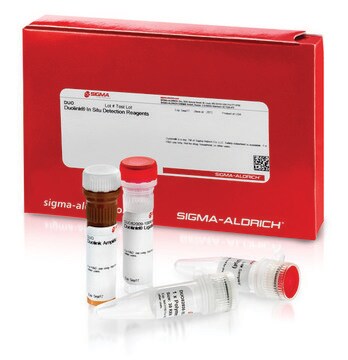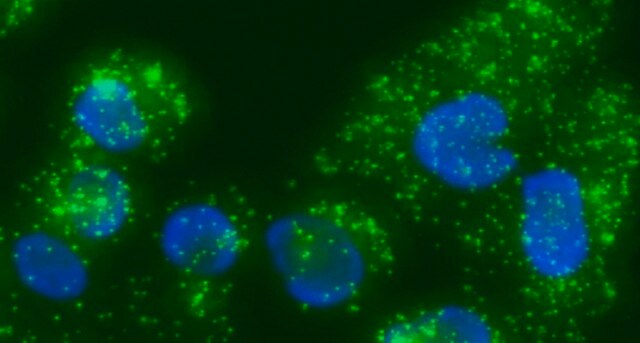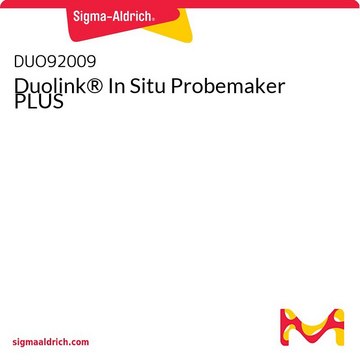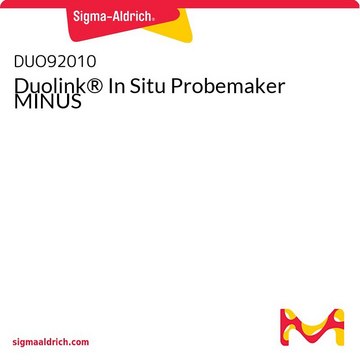DUO92106
Duolink® In Situ Orange Starter Kit Goat/Rabbit
Synonym(s):
in situ Proximity Ligation Assay Kit, Protein Protein Interaction Kit
About This Item
Recommended Products
product line
Duolink®
Quality Level
technique(s)
proximity ligation assay: suitable
fluorescence
λex 554 nm; λem 576 nm (orange) (Cyanine 3; Zeiss Filter set 20)
suitability
suitable for fluorescence
storage temp.
−20°C
Related Categories
Application
Follow the Duolink® In Situ Fluorescence Protocol to use this product. A set of short instructionsis also available.
Visit our Duolink® PLA Resource Center for information on how to run a Duolink® experiment, applications, troubleshooting, and more.
To perform a complete Duolink® PLA in situ experiment you will need two primary antibodies (PLA, IHC, ICC or IF validated) that recognize two target epitopes.This starter kit supplies all other necessary reagents for 30 Duolink® PLA reactions, which include a pair of PLA probes (Anti-Goat PLUS and Anti-Rabbit MINUS), orange detection reagents, wash buffers, and mounting medium. Note that the primary antibodies must come from the same species as the Duolink® PLA probes. Analysis is carried out using standard immunofluorescence assay equipment.
The Duolink® PLA in situ reagents are suitable for use on fixed cells, cytospin cells, cells grown on slide, formalin-fixed, paraffin embedded (FFPE), or tissue (fresh or frozen). No minimum number of cells is required.
Let us do the work for you, learn more about our Custom Service Program to accelerate your Duolink® projects
View full Duolink® product list
Features and Benefits
- No overexpression or genetic manipulation required
- High specificity (fewer false positives)
- Single molecule sensitivity due to rolling circle amplification
- Relative quantification possible
- No special equipment needed
- Quicker and simpler than FRET
- Increased accuracy compared to co-IP
- Publication-ready results
Legal Information
Not finding the right product?
Try our Product Selector Tool.
Kit Components Also Available Separately
Signal Word
Danger
Hazard Statements
Precautionary Statements
Hazard Classifications
Aquatic Chronic 3 - Met. Corr. 1 - Resp. Sens. 1
Storage Class Code
8A - Combustible corrosive hazardous materials
Flash Point(F)
Not applicable
Flash Point(C)
Not applicable
Choose from one of the most recent versions:
Certificates of Analysis (COA)
Sorry, we don't have COAs for this product available online at this time.
If you need assistance, please contact Customer Support.
Already Own This Product?
Find documentation for the products that you have recently purchased in the Document Library.
Customers Also Viewed
2 53BP1 and 9-1-1 to control the G1 DNA damage checkpoint
Articles
Duolink proximity ligation assay used to study neuron interactions furthering neuroscience research.
Protocol for immunofluorescent detection of proteins in cells and tissue
Find Duolink references based on the type of method used, post translational modification detected, and research focus.
Support information including tips and tricks, frequently asked questions, and basic troubleshooting.
Protocols
This page details the Duolink® In Situ Short Protocol for fluorescence detection
Our team of scientists has experience in all areas of research including Life Science, Material Science, Chemical Synthesis, Chromatography, Analytical and many others.
Contact Technical Service







